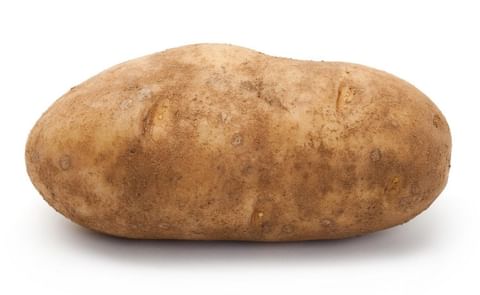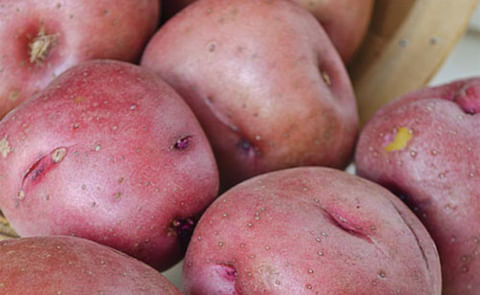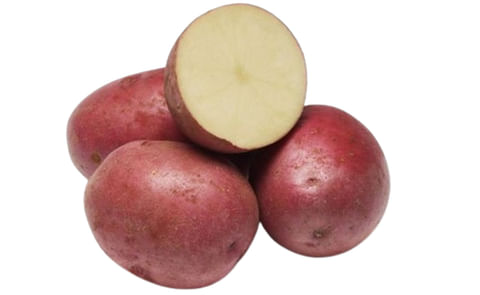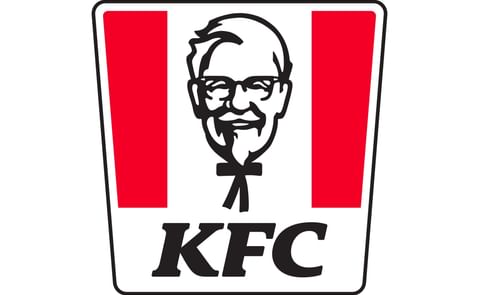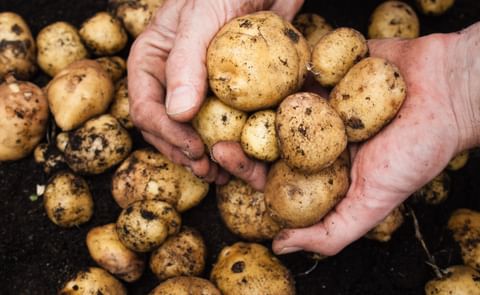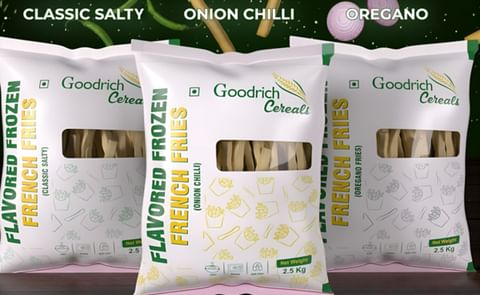This article was originally written for the Badger Common'Tator by Dr. Horia Groza, University of Wisconsin-Madison, retired
The Nutritional Power of Potato: Carbohydrates

The journalist, Ben Feller, wrote, in 2009, an interesting story titled "The President and the Potato." David Letterman hosted President Barack Obama at his talk show and offered 10 funny reasons why his guest accepted to come. But Obama stopped him, saying, "The reason I’m here? I want to see that heart-shaped potato."
A woman in the audience tossed it to him. He caught it and asked permission to take it home. She wonders what happened to that potato. Was it kept on the presidential desk until it shrunk, decayed, or sprouted, or the President gave up and ate it? If he ate it, She thinks he had the unique chance to be convinced again and again by the outstanding nutritive power of this peculiar vegetable.
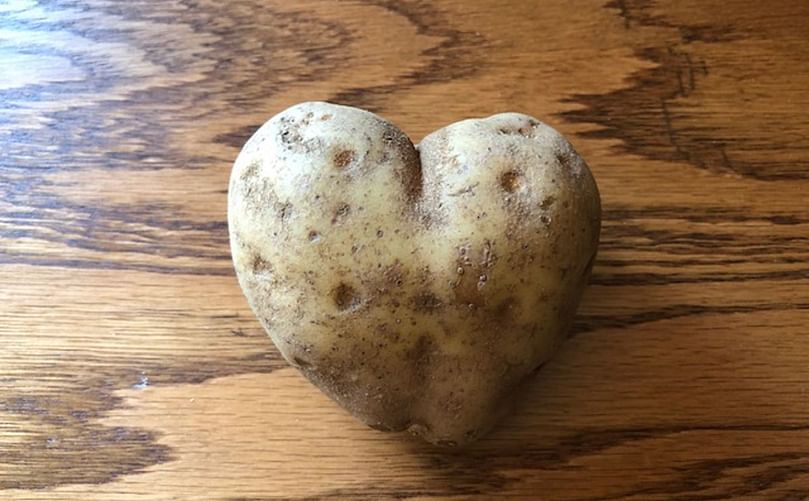 In the 18th century, on small English farms, an acre of potatoes produced three times more energy than wheat, barley, or oats. Traditionally, in the 19th century, in the Old World, an acre of potato crop and a milk cow could feed a family of six to eight persons (Nunn and Qian, QJA 2011).
In the 18th century, on small English farms, an acre of potatoes produced three times more energy than wheat, barley, or oats. Traditionally, in the 19th century, in the Old World, an acre of potato crop and a milk cow could feed a family of six to eight persons (Nunn and Qian, QJA 2011).
Nowadays, four crops (potato, rice, wheat, and maize) supply 50% of the world’s food energy needed, and the 159 countries that grow potatoes represent 82% of all the world’s countries (Wijesinha-Bettoni and Mouille, AJPR 2019).
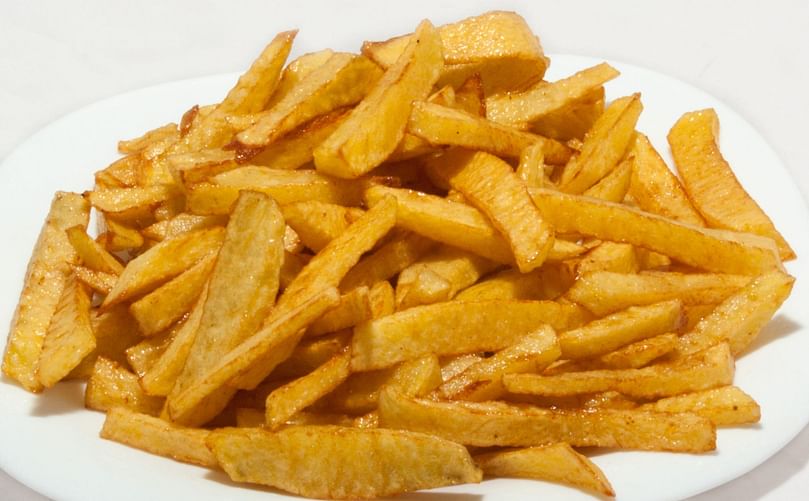 Potato as a staple food
Potato as a staple food
In the United States, potatoes have been a staple food (117 pounds [lbs.] per capita/year in 2013), which is less than 202 lbs./capita in Ireland, 205 lbs./capita in the Netherlands, and 408 lbs./capita in Belarus.
If we consider the amount consumed by men in the United States between 1994 and 1998 (Bamberg and Greenway 2019) as 100%, then, in comparison, boys consumed 80%, girls 62%, and women 60%. This amount decreased in 2007-2008 by about 15% for all, except for boys (30%).
According to Wijesinha-Bettoni and Mouille (AJPR 2019), the content of 100 grams (g.) of fresh weight tubers of the 5,000 varieties of the world is 15.9 g. starch (9.1-19.5 g. cited previously), 2 g. of protein (0.8-4.2), 453 milligrams (mg.) of potassium (250-694), 73.3 mg. phosphorus (33.1-126), 19.3 mg. magnesium (10.9-32.6), 17 mg. vitamin C (2.8-42), 8.8 mg. calcium (0.9-27.8), and .9 mg. iron (0.1-3.9).
Due to its high content of starch, potato is a main source of first quality carbohydrates. Many athletes of high performance know this fact very well. They need carbohydrate food that is absorbed during exercise to avoid gastrointestinal problems and supply the muscles with enough energy (Kanter and Elkin, AJPR 2019).
Before exercise, they eat meals low in glycemic index (GI) for glycogen stores, but after exercise, they eat high GI meals for rapid glycogen re-synthesis.
Potatoes rich in resistant starch (RS) can provide that in the first stage. Potatoes with rapidly digestible starch (RDS) formed after cooking are recommended in the second stage (e.g. .5-.6 g. per kilogram [kg.] of carbs present in a medium-sized tuber or a cup of rice or pasta for every 30 minutes for 2-4 hours).
Moderate Activity
This theory coexists with those based on fat (ketone diet) or protein. One hour of more moderate activity such as walking, jogging, swimming, or bicycling at a modest effort requires 6-7 g. per kg. of body weight/day dietary carbohydrate to restore muscle glycogen content (Kanter and Elkin, AJPR 2019).
The dietary acid imbalance, measured as potential renal acid load (PRAL), contributes to progressive bone and muscle loss.
The impact on mitigating acidosis (PRAL), weighted by U.S. per capita, is tremendous for potatoes: 480, versus 268 for tomatoes, 52 for carrots, and under 36 for the rest of vegetables (Bamberg and Greenway, AJPR 2019).
Potato starch consists of two polysaccharides: amylopectin (branched chain glucose polymer) and amylose (straight chain glucose polymer) in a nearly constant ratio of 3 to 1. The amylopectin breaks the easiest. The cells of the floury varieties (Russet Burbank, Norchip) in contrast to waxy varieties (Red Pontiac, Red LaSoda) are larger with an irregular cell shape, and they rupture or swell faster at cooking.
During boiling, the heat and excess water disrupt the cells, and the starch granules swell within them. Then, gelatinization of starch takes place (breaking down of the intermolecular bonds) and the granules are irreversibly dissolved in water that acts as a plasticizer.
During cooling and storage, a process of retro-gradation occurs while the amylose and amylopectin re- associate and re-form into ordered structures.
Starch Paste
If the cooking continues, the final product becomes a starch paste where the suspension is a dispersion of granules in different disintegration stages and of liberated amylose and amylopectin.
Regarding the digestibility, three categories of potato starch are known: rapidly digestible starch (RDS) hydrolyzed in 20 minutes; slowly digestible starch (SDS) hydrolyzed in 20-120 minutes; and resistant starch (RS) hydrolyzed much later (Dupuis and Liu, AJPR, 2019).
The RDS can be 53-86% of the total starch after boiling. RDS is the most unhealthy starch because it increases the blood glucose and insulin levels. SDS is digested in about the time required to traverse the small intestine.
As a result, SDS provides sustained energy and aids in controlling blood glucose and insulin levels despite the high GI associated with potatoes. The SDS content of cooked potatoes ranges from roughly 10% in boiled potatoes to as little as 1% in instant mashed potatoes.
Adding a cooling treatment that is conducive to retro-gradation, the SDS can increase to 45%. RS is effectively a starch-based fiber fraction that resists intestinal amylolysis and thus passes, undigested, into the large intestine. Raw potatoes have an RS content as high as 75%, but when cooked, RS decreases to 5-10%.
It can be recovered during a cooling period that facilitates retrogradation, as happens in refrigerated potatoes after boiling (Dupuis and Liu, AJPR 2019).
Increase in RS content
An increase in RS content was reached after 24 hours of 4 degrees Celsius cold storage of boiled and fried potatoes (Jayanty et al., AJPR 2019). In the larger intestine, RS might play an important prebiotic role as a fermentation substrate for probiotic bacteria within the colon as Lactobacillus and Bifidobacteria species.
As a result, short-chain fatty acids (SCFA) are excreted that have positive effects on colonocytes and colonic health, preventing colon cancer (Dupuis and Liu, AJPR 2019).
SCFA (acetate, propionate, and butyrate) lower the pH of the gut, reduce toxic levels of ammonia in the GI tract and act as pre-biotics. The Western diet, based on high saturated fat, high sugar, and less fruit and vegetables leads to a perturbed gut bacterial composition that causes chronic intestinal inflammation.
The detrimental bacteria release pro-inflammatory cytokines, followed by endotoxins (lipopolysaccharide, LPS) that are translocated through the damaged colon epithelium into the systemic flow of the human body, triggering inflammation and immune cell infiltration of liver.
This disastrous effect can be prevented by a larger bacterial diversity and an increase of beneficial bacteria, all fed on potato fiber and RS (Reddivari et al., AJPR 2019).
High Satiety of Potato
Despite their high GI, potatoes promote higher satiety than many other foods. RS may enhance satiety. Boiled potatoes are more satiating than equal calorie portions of other common carbohydrate-rich foods like rice, bread, and pasta (Beals, AJPR 2019).
Baked potatoes had more RS than the boiled ones (3.6 g. RS/100 grams vs 2.4 g.). Chilled potatoes (whether originally baked or boiled) contained the most RS (4.3 g./100), followed by chilled-and- reheated potatoes (3.5). In addition to RS, potatoes contain dietary fiber (2 g. in a 5.3 ounce [oz.] potato or 7% of the Daily Value), which is present both in the flesh and skin.
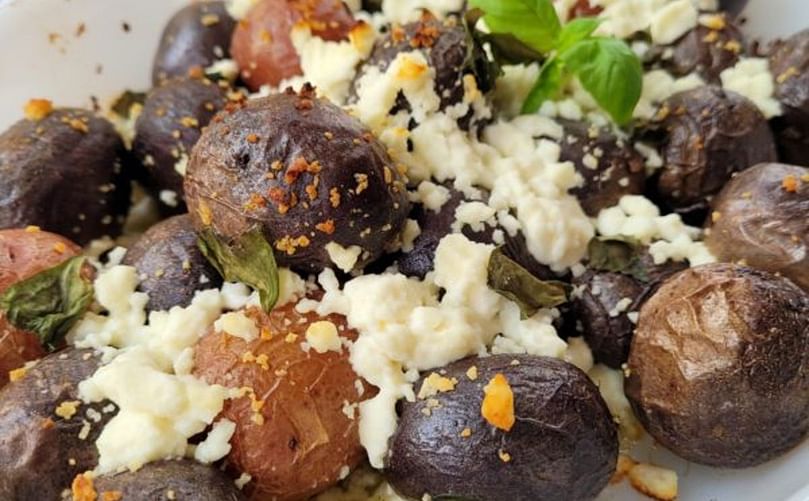 Daily consumption of RS ranges in the United States from 2 to 10 g./day. In China, intake is roughly 18 g./day, and in developing countries, intake may be as high as 40 g./day. Actually, a daily intake of 20 g./day is necessary. This is hard to reach with the current processing operations, which significantly reduce the RS content (Dupuis and Liu, AJPR 2019).
Daily consumption of RS ranges in the United States from 2 to 10 g./day. In China, intake is roughly 18 g./day, and in developing countries, intake may be as high as 40 g./day. Actually, a daily intake of 20 g./day is necessary. This is hard to reach with the current processing operations, which significantly reduce the RS content (Dupuis and Liu, AJPR 2019).
A few words about glycemic index (GI). It varies in North America from medium (56 for boiled reds consumed cold) to moderately high (77 for baked russets) to high (88-89 for instant mashed and boiled reds). French fries are reported to have a GI lower than boiled potatoes (Beals, AJPR 2019).
Decrease Glycemic response
Frying, microwaving, and baking decrease the postprandial (the period after meal) glycemic response, as compared with boiling or mashing. Cooling before consumption and the use of additives such as vinegar decreased GI of potato (Jayanty et al., AJPR 2019). The GI is reduced 50% or more when potato is eaten with other foods (e.g. topped with cheese, or with meat, oil, and salad).
Broccoli alongside mashed potatoes reduced GI by 20% (Balance et al., EJN 2018). The GI of potatoes can also be partially modulated by polyphenol content (effect of RS), which inhibits the intestinal carbohydrate digestive enzymes (Dupuis and Liu, AIPR 2019).
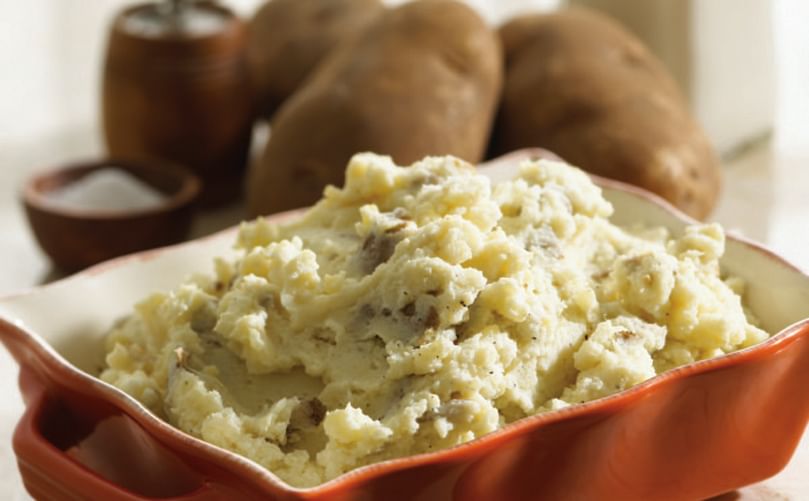 As can be seen in literature regarding the variation of different potato constituents, there is an optimal cooking procedure for every nutritive constituent (starch, GI, vitamins C and B6, potassium, magnesium, iron, carotenoids, and phenolic acids).
As can be seen in literature regarding the variation of different potato constituents, there is an optimal cooking procedure for every nutritive constituent (starch, GI, vitamins C and B6, potassium, magnesium, iron, carotenoids, and phenolic acids).
However, the most detrimental cooking factor is excessive heat and water. Therefore, it seems that microwaving with skin and cooling after boiling or baking are the two most appropriate procedures.
Oprah Winfrey:
A woman in the audience tossed it to him. He caught it and asked permission to take it home. She wonders what happened to that potato. Was it kept on the presidential desk until it shrunk, decayed, or sprouted, or the President gave up and ate it? If he ate it, She thinks he had the unique chance to be convinced again and again by the outstanding nutritive power of this peculiar vegetable.

David Letterman hosted President Barack Obama at his talk show and offered 10 funny reasons why his guest accepted to come. But Obama stopped him, saying, “The reason I’m here? I want to see that heart-shaped potato.” This picture of a heart-shaped potato
Nowadays, four crops (potato, rice, wheat, and maize) supply 50% of the world’s food energy needed, and the 159 countries that grow potatoes represent 82% of all the world’s countries (Wijesinha-Bettoni and Mouille, AJPR 2019).

French fries have a glycemic index lower than boiled potatoes.
In the United States, potatoes have been a staple food (117 pounds [lbs.] per capita/year in 2013), which is less than 202 lbs./capita in Ireland, 205 lbs./capita in the Netherlands, and 408 lbs./capita in Belarus.
If we consider the amount consumed by men in the United States between 1994 and 1998 (Bamberg and Greenway 2019) as 100%, then, in comparison, boys consumed 80%, girls 62%, and women 60%. This amount decreased in 2007-2008 by about 15% for all, except for boys (30%).
According to Wijesinha-Bettoni and Mouille (AJPR 2019), the content of 100 grams (g.) of fresh weight tubers of the 5,000 varieties of the world is 15.9 g. starch (9.1-19.5 g. cited previously), 2 g. of protein (0.8-4.2), 453 milligrams (mg.) of potassium (250-694), 73.3 mg. phosphorus (33.1-126), 19.3 mg. magnesium (10.9-32.6), 17 mg. vitamin C (2.8-42), 8.8 mg. calcium (0.9-27.8), and .9 mg. iron (0.1-3.9).
Due to its high content of starch, potato is a main source of first quality carbohydrates. Many athletes of high performance know this fact very well. They need carbohydrate food that is absorbed during exercise to avoid gastrointestinal problems and supply the muscles with enough energy (Kanter and Elkin, AJPR 2019).
Before exercise, they eat meals low in glycemic index (GI) for glycogen stores, but after exercise, they eat high GI meals for rapid glycogen re-synthesis.
Potatoes rich in resistant starch (RS) can provide that in the first stage. Potatoes with rapidly digestible starch (RDS) formed after cooking are recommended in the second stage (e.g. .5-.6 g. per kilogram [kg.] of carbs present in a medium-sized tuber or a cup of rice or pasta for every 30 minutes for 2-4 hours).
Moderate Activity
This theory coexists with those based on fat (ketone diet) or protein. One hour of more moderate activity such as walking, jogging, swimming, or bicycling at a modest effort requires 6-7 g. per kg. of body weight/day dietary carbohydrate to restore muscle glycogen content (Kanter and Elkin, AJPR 2019).
The dietary acid imbalance, measured as potential renal acid load (PRAL), contributes to progressive bone and muscle loss.
The impact on mitigating acidosis (PRAL), weighted by U.S. per capita, is tremendous for potatoes: 480, versus 268 for tomatoes, 52 for carrots, and under 36 for the rest of vegetables (Bamberg and Greenway, AJPR 2019).
Potato starch consists of two polysaccharides: amylopectin (branched chain glucose polymer) and amylose (straight chain glucose polymer) in a nearly constant ratio of 3 to 1. The amylopectin breaks the easiest. The cells of the floury varieties (Russet Burbank, Norchip) in contrast to waxy varieties (Red Pontiac, Red LaSoda) are larger with an irregular cell shape, and they rupture or swell faster at cooking.
During boiling, the heat and excess water disrupt the cells, and the starch granules swell within them. Then, gelatinization of starch takes place (breaking down of the intermolecular bonds) and the granules are irreversibly dissolved in water that acts as a plasticizer.
During cooling and storage, a process of retro-gradation occurs while the amylose and amylopectin re- associate and re-form into ordered structures.
Starch Paste
If the cooking continues, the final product becomes a starch paste where the suspension is a dispersion of granules in different disintegration stages and of liberated amylose and amylopectin.
Regarding the digestibility, three categories of potato starch are known: rapidly digestible starch (RDS) hydrolyzed in 20 minutes; slowly digestible starch (SDS) hydrolyzed in 20-120 minutes; and resistant starch (RS) hydrolyzed much later (Dupuis and Liu, AJPR, 2019).
The RDS can be 53-86% of the total starch after boiling. RDS is the most unhealthy starch because it increases the blood glucose and insulin levels. SDS is digested in about the time required to traverse the small intestine.
As a result, SDS provides sustained energy and aids in controlling blood glucose and insulin levels despite the high GI associated with potatoes. The SDS content of cooked potatoes ranges from roughly 10% in boiled potatoes to as little as 1% in instant mashed potatoes.
Adding a cooling treatment that is conducive to retro-gradation, the SDS can increase to 45%. RS is effectively a starch-based fiber fraction that resists intestinal amylolysis and thus passes, undigested, into the large intestine. Raw potatoes have an RS content as high as 75%, but when cooked, RS decreases to 5-10%.
It can be recovered during a cooling period that facilitates retrogradation, as happens in refrigerated potatoes after boiling (Dupuis and Liu, AJPR 2019).
Increase in RS content
An increase in RS content was reached after 24 hours of 4 degrees Celsius cold storage of boiled and fried potatoes (Jayanty et al., AJPR 2019). In the larger intestine, RS might play an important prebiotic role as a fermentation substrate for probiotic bacteria within the colon as Lactobacillus and Bifidobacteria species.
As a result, short-chain fatty acids (SCFA) are excreted that have positive effects on colonocytes and colonic health, preventing colon cancer (Dupuis and Liu, AJPR 2019).
SCFA (acetate, propionate, and butyrate) lower the pH of the gut, reduce toxic levels of ammonia in the GI tract and act as pre-biotics. The Western diet, based on high saturated fat, high sugar, and less fruit and vegetables leads to a perturbed gut bacterial composition that causes chronic intestinal inflammation.
The detrimental bacteria release pro-inflammatory cytokines, followed by endotoxins (lipopolysaccharide, LPS) that are translocated through the damaged colon epithelium into the systemic flow of the human body, triggering inflammation and immune cell infiltration of liver.
This disastrous effect can be prevented by a larger bacterial diversity and an increase of beneficial bacteria, all fed on potato fiber and RS (Reddivari et al., AJPR 2019).
High Satiety of Potato
Despite their high GI, potatoes promote higher satiety than many other foods. RS may enhance satiety. Boiled potatoes are more satiating than equal calorie portions of other common carbohydrate-rich foods like rice, bread, and pasta (Beals, AJPR 2019).
Baked potatoes had more RS than the boiled ones (3.6 g. RS/100 grams vs 2.4 g.). Chilled potatoes (whether originally baked or boiled) contained the most RS (4.3 g./100), followed by chilled-and- reheated potatoes (3.5). In addition to RS, potatoes contain dietary fiber (2 g. in a 5.3 ounce [oz.] potato or 7% of the Daily Value), which is present both in the flesh and skin.

The glycemic index is reduced 50% or more when potato is eaten with other foods (e.g. topped with cheese, or with meat, oil, and salad), such as here in a recipe for baked lemon and feta potatoes.
A few words about glycemic index (GI). It varies in North America from medium (56 for boiled reds consumed cold) to moderately high (77 for baked russets) to high (88-89 for instant mashed and boiled reds). French fries are reported to have a GI lower than boiled potatoes (Beals, AJPR 2019).
Decrease Glycemic response
Frying, microwaving, and baking decrease the postprandial (the period after meal) glycemic response, as compared with boiling or mashing. Cooling before consumption and the use of additives such as vinegar decreased GI of potato (Jayanty et al., AJPR 2019). The GI is reduced 50% or more when potato is eaten with other foods (e.g. topped with cheese, or with meat, oil, and salad).
Broccoli alongside mashed potatoes reduced GI by 20% (Balance et al., EJN 2018). The GI of potatoes can also be partially modulated by polyphenol content (effect of RS), which inhibits the intestinal carbohydrate digestive enzymes (Dupuis and Liu, AIPR 2019).

Adding broccoli to mashed potatoes might lower the glycemic index by 20%.
However, the most detrimental cooking factor is excessive heat and water. Therefore, it seems that microwaving with skin and cooling after boiling or baking are the two most appropriate procedures.
Oprah Winfrey:
"My idea of heaven is a great big baked potat o and someone to share it with. I think she should adjust a little bit regarding the cooking."Horia Groza:
"Did he realize when looking at the heart-shaped tuber that potato is, for very many people, the heart of their nutritional intake?
Like to receive news like this by email? Join and Subscribe!
NEW! Join Our BlueSky Channel for regular updates!
精选企业
Potato varieties mentioned
Sponsored Content
Sponsored Content
Sponsored Content
Sponsored Content
Sponsored Content


